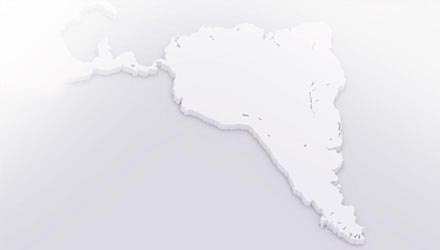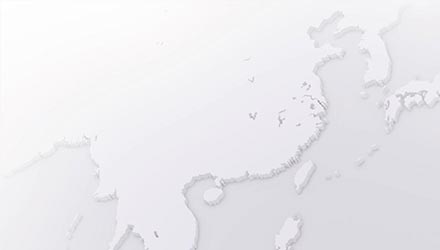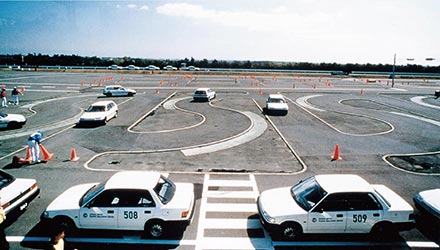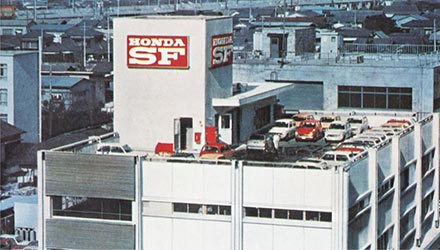Starting Local Production in Oil-booming Nigeria
to Begin Full-fledged Operations in Africa
Nigeria is Africa’s largest economy, with a population of over 200 million in a landmass approximately 2.5 times the size of Japan. It is also known as one of Africa’s leading oil-producing countries.
Honda business in Africa started in the 1960s, with exports to Nigeria of mopeds manufactured by Honda Motor in Belgium (later to become Belgium Honda or BH). However, due to restrictions on imports from Japan, among other factors, Honda was not fully engaged in market cultivation activities. Years passed without any real business expansion.
In the 1970s, however, Nigeria became a major market for Honda. The first oil crisis that shook the world economy brought an oil boom to Nigeria, and sales of consumer durables, including automobiles and motorcycles, began to increase significantly. Since Nigeria was producing the best quality crude oil among oil-producing countries, huge amounts of oil money began to enrich its society.
Honda sales of motorcycles also increased rapidly. In 1974, Honda had been importing about 1,000 motorcycles per month, mainly from Europe, but this number quickly increased tenfold to 10,000 per month.
Honda was convinced that the local production of motorcycles was inevitable.
After negotiations with Leventis Motors, a local distributor (importer), and repeated negotiations with Nigerian government officials, Honda Manufacturing (Nigeria) Limited (HMN), a joint venture with Leventis to sell motorcycles and power products, was established in July 1979 in Ota, Ogun State. By October, Honda had already begun plant construction.
However, Honda faced many difficulties. At that time, Nigeria did not have well-developed infrastructure, and power outages occurred daily. Each time this happened, lights went out and fans stopped working. In addition, water and sewage systems were not well maintained, so when it rained, cars on the streets were often submerged in water. Furthermore, food was also a challenge for Japanese expatriates. For sanitary reasons, they could not drink tap water nor eat raw vegetables. Since Japanese food was not available, instant noodles they brought with them were a precious commodity. Despite such a harsh environment, the expatriates began by breaking ground on a vacant lot, then hiring local staff, and providing technical guidance while inspiring and encouraging them.
A modern plant equipped to assemble, weld and paint motorcycles, was completed and production began in January 1981, using parts supplied from Japan.

HMN motorcycle plant was established in a difficult environment with insufficient infrastructure in place. Photo depicts final inspection line.
An Unprecedented Crisis:
Local Distributor Saved Honda in Desperate Efforts
to Collect Payments

HMN motorcycle plant began production in 1980.
With its production system in place, HMN was well on its way to success in the Nigerian market. However, the company soon encountered an unexpected problem: to meet strong demand, the company began importing large quantities of parts from Japan, but payments for such parts were not being remitted to Japan, making the Japanese suppliers anxious while waiting for the payments.
The problem was that soaring prices for crude oil suddenly fell, and the foreign currency (U.S. dollars) Nigeria acquired through crude oil exports became scarce. Meanwhile, HMN was processing the payments for the imported assembly parts by first transferring the amount to the Central Bank of Nigeria in Nigerian currency (naira), which would be converted into U.S. dollars and be remitted to Japan. So, due to the shortage of U.S. dollars, the payments by the Central Bank to Japan were not settled and the money could not be remitted. Moreover, due to the economic turmoil, the naira began to depreciate, making it even more difficult to ensure the payments.
In order to make full payment, HMN had to ask its distributor, Leventis, to secure enough naira, which was losing value every day, while persistently requesting the Central Bank of Nigeria to allocate its limited U.S. dollars for the payments to Japan. Clearing these two hurdles was extremely difficult, and Honda expatriates in Nigeria and their counterparts in Japan endured sleepless nights of uncertainty.
Honda started to see a ray of hope thanks largely to the efforts of Leventis, a blue-chip company that operated not only Honda motorcycle distribution business, but also a broad range of businesses including hotels and supermarkets. Leventis even transferred funds that had been earmarked for other businesses to enable HMN to secure enough naira to make payments to Japan.
Based on the long and deep relationship Honda and Leventis had built through the import and sales of Honda products which began in the 1960s, and the joint venture business started with the establishment of HMN, Leventis was sincere in its support to make remittance to Honda in Japan. Moreover, with the help of Leventis, Honda obtained an allocation of U.S. dollars from the Central Bank of Nigeria.
Based on such desperate efforts made by Leventis and HMN, in 1984, Honda was able to collect the full amount of the outstanding payments. However, shortly after that, Honda faced an even greater challenge that threatened the very survival of HMN.
HMN Overcomes Existential Threat Through Ingenuity
The drop in oil prices in 1983 disrupted the Nigerian economy. In the aftermath, motorcycle sales stagnated. Annual production of 100,000 motorcycles had dropped by 90 percent to 10,000, and by 1986 dropped further to just over 3,000 units.
Some motorcycle manufacturers experiencing the same difficulties withdrew from Nigeria. The survival of HMN was at stake, but the company decided to stay the course so that the hard work it had invested would not be in vain. Daily operating hours were cut in half, and the number of associates had to be reduced from 480 to 180. The factory, which had been alive with the sound of machinery, was quiet, and the remaining associates, including Japanese expatriates, experienced days filled with doubt.
However, HMN was committed to surviving at all costs, and the unique ingenuity of Honda, especially in such times, came into play. The president of HMN and the local associates were determined to do whatever they could to reduce costs and make a profit.
Various ideas were proposed for the factory’s survival and revitalization. It was like a Nigerian version of “All Honda Idea Contest*1.” Some of the ideas, such as commercializing the 50-ton-per-hour water that gushes from the factory grounds, fell through without even trying due to the estimated cost. But HMN tested a wide variety of ideas, such as using the large amount of soft and soluble paper, intended to be used as cushioning material for packing parts, as toilet paper. There were some profitable ideas, such as one proposed by an expatriate who, while visiting a distributor, saw local people cutting corrugated cardboard to use as gaskets. This inspired HMN to hastily produce gaskets in-house using suitable materials at the plant.
Through these efforts toward revitalization, HMN gradually became profitable. In 1979, HMN was able to pay a dividend for the first time since its establishment. It was a small amount, as small as 25 million yen at the time, but it was truly the result of everyone's commitment and hard work.
- The “All-Honda Idea Contest,” held from 1970, began the year after Mr. Soichiro Honda saw a costume parade among the different divisions at a sports day held at the then Sayama Plant and said to himself, “This is interesting. This is the sports festival of Honda dreams and brains.” Many of the associates, who had been realizing their dreams in their free time away from work, learned the joy as well as the difficulties of monozukuri (the art of making things).
Utilizing the Honda Global Network to Offer High-quality
and Affordable Motorcycles to More Customers

HMN-manufactured CG125 (1989)
While the market had become extremely small, the HMN-made CG125 motorcycle was a popular model in Nigeria. In 1989, HMN began importing assembly parts from Brazil instead of Japan, mainly to reduce costs, and introduced a new model, the CGl 25NR.
HMN wanted to make Honda motorcycles more affordable to more customers.
However, the economic downturn in Nigeria, which would continue for a long time, dramatically changed the course of the motorcycle market. In the late 1990s, the influx of motorcycle imports began from countries including Japan, and from the late 1990s, Chinese-made counterfeits entered the market at price points only slightly higher than used bikes. With their low prices, China dominated up to 90 percent of the Nigerian market.
In Nigeria, motorcycles were still an expensive commodity for the average citizen, and for Honda, corporations were its main customers. While the number of “okadas” (motorcycle taxis) was increasing as a means of transportation for the general public, especially in urban areas, most of the motorcycle taxi drivers were opting for Chinese-made counterfeits.
These counterfeits were imitations of Honda motorcycles, costing the customer less than half the price, but of greatly inferior quality. This was already a major problem for Honda in China. The solution Honda adopted in China was to manufacture and sell products that were high quality yet affordable, through its joint venture in China, Wuyang-Honda Motorcycle (Guangzhou) Co., Ltd.
To address the issue in Nigeria, HMN decided to obtain assembly parts from Wuyang Honda. Then, in 2002 launched the CGL125, a high quality product worthy of the Honda brand, yet priced competitively enough to compete with Chinese counterfeits. In addition to its high durability and excellent fuel economy, the CGL125 featured a long seat that enhanced comfort for passengers and a rear luggage rack with high load capacity, making it suitable for use as motorcycle taxi, and HMN took on a challenge to gain new customers in that segment.
Once launched, the CGL125 was initially regarded as slightly more expensive than Chinese motorcycles, but after one year, its good quality and low running cost became known among motorcycle taxi riders, and the CGL125's market share gradually increased. In the mid-2000s, however, more small motorcycles entered the market, this time from India. They sat in the price range between those made by Honda and those made in China.
Facing even tougher price competition, HMN launched new low-priced strategic models in 2011: the Ace CB125 for the motorcycle taxi market, and the Ace CB125D with styling and modern design appealing to a wide range of customers. In 2013, HMN launched the CG110, a 110 cc class model with an even lower price, and in 2017, the Ace110, also in the 110 cc class, suitable for business use. With these models, HMN launched more aggressive sales activities to further increase sales volume.
In 2019, HMN celebrated its 40th anniversary, and in the same year reached the 1 million-unit milestone for cumulative production. Since its establishment, HMN has been taking on and winning price competitions against a number of Chinese and Indian brands by ensuring high practicality and durability of Honda products and by continuing in-house assembly, inspection and production management, which enabled HMN to win the trust of approximately 160 dealers and their customers in Nigeria.
In the midst of a constantly unstable market environment, where the amount of foreign currency reserves repeatedly fluctuated depending on the fluctuation of oil prices, HMN has constantly made strenuous efforts to offer high-quality motorcycles suited to the region at more affordable prices, doing so by leveraging the global Honda network in coordination with Honda in Japan. The reason for this continued effort is nothing other than the strong desire of HMN to offer motorcycles that Nigerian customers can use with peace of mind, for a long time, as part of essential transportation infrastructure in their daily lives.

CG110 (2013)

Ace110 (2017) all-new small motorcycle suitable for business use
Honda Automobile Business in South Africa:
Applying Best Efforts with Localized Business Styles
 Honda automobile production in South Africa started in the form of consigned production by UCDD, beginning with the Ballade.
Honda automobile production in South Africa started in the form of consigned production by UCDD, beginning with the Ballade.
South Africa is the second largest economy among African countries, and together with the largest economy, Nigeria, is the driving force of the overall African economy. Since the discovery of diamonds and gold in the late 19th century, the mining industry has taken the lead, and manufacturing and other industries have developed using the capital generated from mining. As a result, modernization has progressed, and South Africa became the earliest African country to achieve motorization. Highways extend far beyond the horizon, and cars of the world's major automobile brands can be seen in urban areas.
Honda automobile production in South Africa began in October 1982, with the compact four-door Ballade sedan. The process of entering the market, however, was not simple. At the time, South Africa had a total ban on imports of completed automobiles, and even if local production was undertaken, there were extremely strict regulations on the local procurement of parts. Although the market was large, with an annual automobile production volume of approximately 200,000 units, in reality it was next to impossible for Honda to enter the market.
However, an opportunity presented itself to open the door to new possibilities. A local distributor Honda already had a business relationship with in exporting motorcycles and power product parts, provided insight into a new development toward deregulation within the South African government. In addition, the distributor suggested that Honda should partner with United Car and Diesel Distributors (UCDD), a Mercedes-Benz distributor also engaged in production at the time, if intending to begin production. After repeated negotiations, Honda signed a technical collaboration agreement with UCDD. The scope of the agreement included the production of the Honda Ballade by USDD and sales through UCDD dealers.
In 1983, soon after its market launch, the South African-made Ballade was highly acclaimed, winning the 1983 Car of the Year award in the compact car category from the influential local newspaper The STAR. This recognition gave Ballade production a boost.
Honda then opened a representative office, and local production was expanded to include the Civic 3-door and Ballade (Civic 4-door), and in the 18 years through 2000, sales of vehicles produced in South Africa reached approximately 175,000 units. Honda operation in South Africa reached a major turning point in the same year.
 Honda was ranked the No.1 brand in the 2004 Initial Quality Study (IQS) conducted by J.D. Power and Associates in South Africa.
Honda was ranked the No.1 brand in the 2004 Initial Quality Study (IQS) conducted by J.D. Power and Associates in South Africa.
Honda and Daimler Chrysler South Africa (DCSA, renamed from UCDD) agreed to dissolve their alliance at the end of 2000, and announced that they would reformulate their own business strategies for the South African market from a long-term perspective. Honda paid tribute to DCSA, which had been involved in the production and sales of Honda vehicles and brand building in South Africa for many years. As a result of the discontinuation of the partnership, local production of Honda vehicles ended in 2000, and Honda established a local subsidiary, Honda South Africa, which later became Honda Motor Southern Africa (HSAF), in June 2000. Since South Africa’s import regulations had changed, HSAF made a new start as an importer and distributor of Honda motorcycles, automobiles, and power products.
HSAF expanded its sales by offering a diverse product lineup unique only to Honda. In motorcycle business, HSAF achieved the number one market share in South Africa in 2003. In automobile business, Honda was named the number one brand in the first Initial Quality Study (IQS) J.D. Power and Associates conducted in 2004, including all automobile manufacturers in South Africa. In 2007, the new Civic became the first Honda car to win the South African Car of the Year award.
In power products business, based in South Africa, Honda offered a variety of products and services, including not only general-purpose engines and generators, but also other power products for green (agricultural and gardening) and marine businesses, that would help people in their daily lives in the southern region of Africa,
Offering the Joy of Mobility
to as Many Customers as Possible through
Automobile Business in Nigeria
In 1992, HMN opened Nigeria’s first dedicated Honda automobile showroom as a part of its automobile sales channel.
In 2013, Honda established Honda Automobile Western Africa (HAWA), a local subsidiary to import and sell automobiles and automotive parts. Then in 2015, the first Honda automobile production plant in Africa became operational and began assembly of the Accord.






